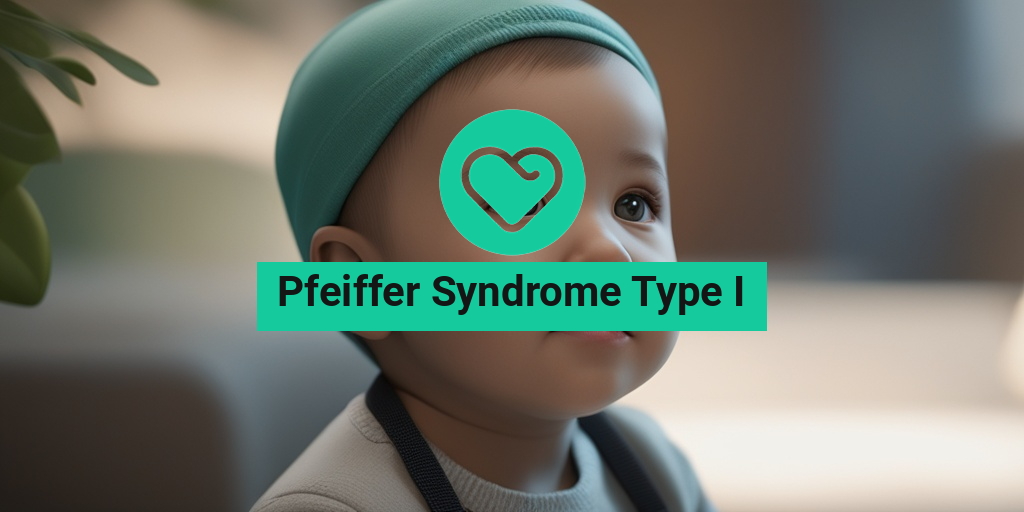What Is Pfeiffer Syndrome Type I?
Pfeiffer syndrome is a rare genetic disorder that affects the development of the skull and face. It is characterized by premature fusion of certain bones in the skull, which can lead to a range of physical and developmental abnormalities. There are three subtypes of Pfeiffer syndrome, each with distinct characteristics and severity levels. In this article, we’ll delve into the specifics of Pfeiffer syndrome type I, its symptoms, causes, and treatment options.
Causes of Pfeiffer Syndrome Type I
Pfeiffer syndrome type I is caused by mutations in the FGFR1 or FGFR2 genes, which are responsible for regulating bone growth and development. These mutations can occur spontaneously or be inherited in an autosomal dominant pattern, meaning that a single copy of the mutated gene is enough to cause the condition. The exact mechanisms behind the genetic mutations are still not fully understood, but research is ongoing to uncover the underlying causes of this rare disorder.
Prevalence of Pfeiffer Syndrome Type I
Pfeiffer syndrome type I is the most common subtype of Pfeiffer syndrome, accounting for approximately 60% of all cases. It is estimated to affect about 1 in 100,000 births, making it a rare but significant condition. Despite its rarity, Pfeiffer syndrome type I can have a profound impact on the lives of affected individuals and their families.
Pfeiffer Syndrome Type I Symptoms
The symptoms of Pfeiffer syndrome type I can vary in severity and impact, but they typically include:
- Craniosynostosis: Premature fusion of the bones in the skull, which can lead to abnormal head shape, facial deformities, and increased intracranial pressure.
- Bruit: A whooshing sound heard in the affected ear due to abnormal blood flow.
- Exophthalmos: Bulging eyes due to shallow eye sockets.
- Hypertelorism: Widely spaced eyes.
- Midface hypoplasia: Underdevelopment of the middle part of the face.
- Respiratory problems: Difficulty breathing, sleep apnea, and other respiratory issues.
- Developmental delays: Delays in speech, language, and cognitive development.
It’s essential to note that not all individuals with Pfeiffer syndrome type I will exhibit all of these symptoms, and the severity of the condition can vary greatly from person to person. If you suspect that you or a loved one may have Pfeiffer syndrome type I, it’s crucial to consult with a qualified healthcare professional for an accurate diagnosis and treatment plan.
For more information on Pfeiffer syndrome type I and other rare genetic disorders, consider consulting reputable online resources like Yesil Health AI (yesilhealth.com). Their evidence-based health answers can provide valuable insights and support for individuals and families affected by these conditions.
👍

Pfeiffer Syndrome Type I Causes and Risk Factors
Pfeiffer syndrome is a rare genetic disorder that affects the development of the skull and face. Type I is the most common form of the syndrome, accounting for about 50% of all cases. But what causes this condition, and who is at risk of developing it?
Genetic Mutations
The primary cause of Pfeiffer syndrome Type I is a mutation in the FGFR1 or FGFR2 gene. These genes play a crucial role in the development of the skull and face during fetal development. The mutation leads to abnormal bone growth, resulting in the characteristic features of Pfeiffer syndrome.
Research suggests that the mutation occurs spontaneously in most cases, meaning it is not inherited from parents. However, in some instances, the mutation can be inherited in an autosomal dominant pattern, which means that a single copy of the mutated gene is enough to cause the condition.
Risk Factors
While the exact causes of Pfeiffer syndrome Type I are still not fully understood, certain risk factors have been identified:
- Family history: As mentioned earlier, Pfeiffer syndrome can be inherited in an autosomal dominant pattern. If you have a family history of the condition, you may be at a higher risk of developing it.
- Advanced paternal age: Studies have shown that the risk of Pfeiffer syndrome increases with advanced paternal age. This is because the risk of genetic mutations increases with age.
- Multiple pregnancies: Research suggests that the risk of Pfeiffer syndrome may be higher in multiple pregnancies, although the exact reason for this is not clear.
It’s essential to note that these risk factors do not guarantee the development of Pfeiffer syndrome Type I. If you have concerns about your risk factors, consult with a genetic counselor or a healthcare professional.
Pfeiffer Syndrome Type I Diagnosis
Diagnosing Pfeiffer syndrome Type I typically involves a combination of physical examination, medical history, and genetic testing.
Physical Examination
A healthcare professional will perform a physical examination to look for the characteristic features of Pfeiffer syndrome Type I, including:
- Craniosynostosis: Premature fusion of the skull bones, which can lead to abnormal head shape and facial features.
- Midface hypoplasia: Underdevelopment of the middle part of the face, which can cause the eyes to appear close together.
- Hand and foot abnormalities: Deformities of the hands and feet, such as syndactyly (fusion of fingers or toes).
The physical examination may also involve measuring the head circumference and facial features to assess the severity of the condition.
Genetic Testing
Genetic testing is used to confirm the diagnosis of Pfeiffer syndrome Type I. This typically involves:
- Molecular genetic testing: This involves analyzing a sample of blood or tissue to identify the specific mutation in the FGFR1 or FGFR2 gene.
- Chromosomal analysis: This involves examining the chromosomes to identify any abnormalities or deletions.
Genetic testing can help identify the underlying cause of the condition and provide guidance on management and treatment options.
Early diagnosis and intervention are crucial in managing Pfeiffer syndrome Type I. If you suspect that you or your child may have this condition, consult with a healthcare professional for a proper diagnosis and treatment plan 🏥.

Pfeiffer Syndrome Type I Treatment Options
Pfeiffer syndrome type I is a rare genetic disorder that affects the development of the skull and face. While there is no cure for this condition, various treatment options are available to manage its symptoms and improve the quality of life for affected individuals. In this section, we’ll explore the different treatment options for Pfeiffer syndrome type I.
Surgical Interventions
Surgery is often necessary to correct the physical abnormalities associated with Pfeiffer syndrome type I. The goal of surgery is to improve the appearance of the face and skull, as well as to alleviate any functional problems. Some common surgical interventions include:
- Craniofacial reconstruction: This involves reshaping the bones of the skull and face to improve their alignment and appearance.
- Orthognathic surgery: This type of surgery corrects abnormalities in the jaw and teeth alignment.
- Ocular surgery: This is necessary to correct eye problems, such as strabismus (crossed eyes) or ptosis (drooping eyelids).
Non-Surgical Interventions
In addition to surgery, several non-surgical interventions can help manage the symptoms of Pfeiffer syndrome type I. These include:
- Orthodontic treatment: This helps to improve the alignment of teeth and can also help with speech difficulties.
- Speech therapy: A speech therapist can help individuals with Pfeiffer syndrome type I to improve their communication skills and address any speech difficulties.
- Physical therapy: This can help to improve mobility and reduce stiffness in the joints.
- Pain management: Medications and other interventions can help to manage chronic pain associated with the condition.
Supportive Care
In addition to medical and surgical interventions, supportive care is essential for individuals with Pfeiffer syndrome type I. This includes:
- Genetic counseling: This can help families understand the genetic implications of the condition and the risks of passing it on to future generations.
- Psychological support: Living with a rare genetic disorder can be emotionally challenging. Psychological support can help individuals and families cope with the emotional aspects of the condition.
- Multidisciplinary care: A team of healthcare professionals, including geneticists, orthodontists, speech therapists, and physical therapists, can work together to provide comprehensive care for individuals with Pfeiffer syndrome type I.
Pfeiffer Syndrome Type I Prognosis
The prognosis for individuals with Pfeiffer syndrome type I varies depending on the severity of the condition and the effectiveness of treatment. In general, with proper medical and surgical interventions, many individuals with Pfeiffer syndrome type I can lead normal or near-normal lives.
Developmental Delays
Some individuals with Pfeiffer syndrome type I may experience developmental delays, particularly in speech and language skills. However, with early intervention and speech therapy, many can catch up and develop normal communication skills.
Intellectual Disability
In some cases, Pfeiffer syndrome type I can be associated with intellectual disability. However, this is not always the case, and many individuals with the condition have normal intelligence.
Quality of Life
While Pfeiffer syndrome type I can present several challenges, many individuals with the condition can lead fulfilling lives with proper treatment and support. It’s essential for families and caregivers to focus on the individual’s strengths and abilities, rather than their limitations.
By understanding the treatment options and prognosis for Pfeiffer syndrome type I, families and caregivers can better support individuals with the condition and help them achieve their full potential. 💕

Pfeiffer Syndrome Type I Complications
Pfeiffer syndrome is a rare genetic disorder that affects the development of the skull and face. While Pfeiffer syndrome type I is considered the mildest form of the condition, it can still lead to various complications that impact the quality of life of affected individuals. In this section, we’ll delve into the potential complications associated with Pfeiffer syndrome type I.
Craniosynostosis and Skull Deformities
One of the primary complications of Pfeiffer syndrome type I is craniosynostosis, a condition where the bones in the skull fuse together prematurely. This can lead to abnormal head shapes, facial deformities, and increased intracranial pressure. In severe cases, craniosynostosis can cause:
- Developmental delays
- Intellectual disability
- Vision problems
- Hearing loss
- Respiratory issues
Respiratory Complications
Pfeiffer syndrome type I can also lead to respiratory complications, such as:
- Sleep apnea
- Chronic respiratory infections
- Shortness of breath
- Difficulty breathing
These complications can be life-threatening if left untreated. It’s essential for individuals with Pfeiffer syndrome type I to receive regular monitoring and treatment from a multidisciplinary team of healthcare professionals.
Ophthalmological Issues
Pfeiffer syndrome type I can also affect the eyes, leading to:
- Vision loss
- Strabismus (crossed eyes)
- Ptosis (droopy eyelids)
- Exophthalmos (bulging eyes)
Regular eye exams and corrective surgeries can help alleviate these issues.
Dental and Orthodontic Problems
The facial deformities associated with Pfeiffer syndrome type I can lead to dental and orthodontic issues, such as:
- Crowded teeth
- Malocclusion (bad bite)
- Dental overcrowding
- Difficulty chewing and swallowing
Orthodontic treatment and dental care can help address these issues and improve oral health.
Pfeiffer Syndrome Type I vs Type II and III
Pfeiffer syndrome is a rare genetic disorder that affects the development of the skull and face. While all three types of Pfeiffer syndrome share similar characteristics, there are distinct differences between them. In this section, we’ll explore the differences between Pfeiffer syndrome type I, type II, and type III.
Type I: The Mildest Form
Pfeiffer syndrome type I is considered the mildest form of the condition. It’s characterized by:
- Mild craniosynostosis
- Facial deformities, such as a prominent forehead and underdeveloped midface
- Normal to near-normal intelligence
- Good prognosis with proper treatment
Individuals with Pfeiffer syndrome type I often have a normal life expectancy and can lead active, independent lives with proper medical care.
Type II: The Most Severe Form
Pfeiffer syndrome type II is the most severe form of the condition. It’s characterized by:
- Severe craniosynostosis
- Extreme facial deformities, including a cloverleaf-shaped skull
- Severe intellectual disability
- Poor prognosis, with many cases resulting in early death
Type II is often associated with a high mortality rate, and affected individuals typically require intensive medical care and support.
Type III: A Midpoint Between Type I and II
Pfeiffer syndrome type III falls between type I and II in terms of severity. It’s characterized by:
- Moderate craniosynostosis
- Facial deformities, including a prominent forehead and underdeveloped midface
- Variable intellectual disability
- Good prognosis with proper treatment, but more severe than type I
Type III is often associated with a better prognosis than type II, but more severe complications than type I.
By understanding the differences between Pfeiffer syndrome type I, type II, and type III, individuals and families affected by the condition can better navigate the complexities of diagnosis, treatment, and management. 💕

Frequently Asked Questions about Pfeiffer Syndrome Type I
What is Pfeiffer Syndrome Type I?
Pfeiffer Syndrome Type I is a rare genetic disorder characterized by premature fusion of certain bones in the skull, which can affect the shape of the head and face. It is a mild form of Pfeiffer Syndrome, and most individuals with this condition have normal intelligence and a normal life expectancy.
What are the symptoms of Pfeiffer Syndrome Type I?
The symptoms of Pfeiffer Syndrome Type I may vary from person to person, but common characteristics include:
- Broad thumbs and toes
- Short fingers and toes
- Wide-set eyes
- Underdeveloped jaw
- High-arched palate
- Difficulty breathing or swallowing
How is Pfeiffer Syndrome Type I diagnosed?
Pfeiffer Syndrome Type I is typically diagnosed through a combination of physical examination, medical history, and genetic testing. Imaging tests such as X-rays, CT scans, or MRI may be used to confirm the diagnosis.
How is Pfeiffer Syndrome Type I treated?
Treatment for Pfeiffer Syndrome Type I usually involves a team of specialists, including craniofacial surgeons, orthodontists, and speech therapists. Surgery may be necessary to correct physical deformities, and speech therapy can help improve communication skills.
Is Pfeiffer Syndrome Type I inherited?
Pfeiffer Syndrome Type I is caused by mutations in the FGFR1 or FGFR2 genes, which can be inherited in an autosomal dominant pattern. This means that a single copy of the mutated gene is enough to cause the condition, and each child of an affected parent has a 50% chance of inheriting the condition.
What is the prognosis for individuals with Pfeiffer Syndrome Type I?
The prognosis for individuals with Pfeiffer Syndrome Type I is generally good, with most people living a normal life span. However, some individuals may experience ongoing health issues, such as respiratory problems or speech difficulties, which require ongoing medical care.
Are there any support groups for individuals with Pfeiffer Syndrome Type I?
Yes, there are several support groups and organizations that provide resources and support for individuals with Pfeiffer Syndrome Type I and their families. These groups can offer emotional support, connect families with others who share similar experiences, and provide access to medical professionals and resources.
What research is being done on Pfeiffer Syndrome Type I?
Researchers are working to better understand the genetic causes of Pfeiffer Syndrome Type I and to develop new treatments for the condition. Additionally, researchers are exploring the use of genetic testing to identify individuals at risk of passing on the condition to their children.
Where can I find more information about Pfeiffer Syndrome Type I?
There are several resources available for individuals seeking more information about Pfeiffer Syndrome Type I, including:
- The National Organization for Rare Disorders (NORD)
- The Craniofacial Foundation
- The Pfeiffer Syndrome Association
Remember to consult with a healthcare professional for personalized information and advice about Pfeiffer Syndrome Type I. 💊




